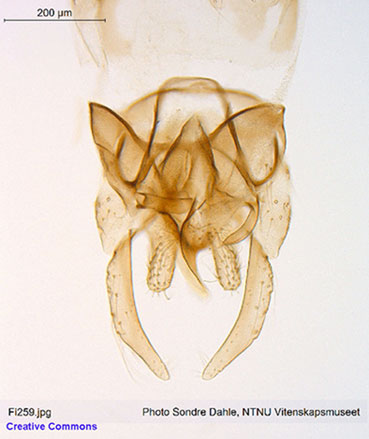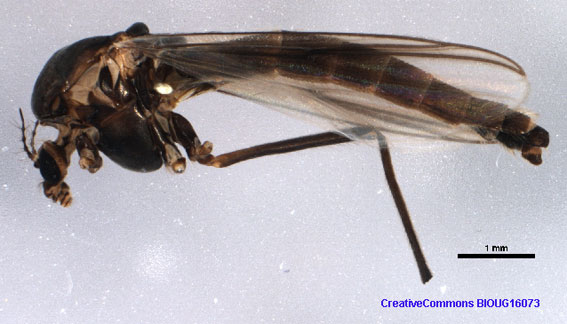Species 4u. Chironomus species NAIII of Proulx et al. In BOLD Bin: BOLD:AAV3582
A specimen in this Bin is named as C. c.f. venustus.
This presumably refers to C. venustus sensu Pinder 1978, not sensu Staeger 1839 which has an S-type Superior volsella. The Pinder species probably requires a new name, pending further investigation (Spies & Sæther 2004).Adult: based on photos associated with the BOLD Bin.
A dark species, with lighter patches on sides of thorax.Male: 
Superior volsella closest to E(g) of Strenzke (1959),
but not tapering towards the end;
Inferior volsella extending to about the end of the anal point.
Gonopophysis relatively long and narrow,
tapering gradually over posterior third.
Female:  Wing length about 5.25 mm.
Rear F/T about 1. Pupa: not known Larva A medium salinarius-type larva, length about 10 - 18 mm.
The frontoclypeus is pale and the gular region is darkened on posterior half.
The c2 teeth of the mentum trifid tooth are partially separated from the c1 tooth (type B); 4th laterals reduced to about the same height as the 5th lateral teeth (type II).
Anterior margin of the ventromental plate is smooth, with about 36-42 striae reaching to about centre of the plate and then with fewer striae reaching about 2/3 of way to anterior margin.
Pecten epipharyngis with 9-15 pointed and rather uniform teeth. Premandible with broad inner tooth (ty. 2B1) about 2.5-3.2 times wider than the outer tooth.
Antenna with ratio of A1/A2 from 3.1-3.8; which is slightly lower than that of the very similar C. cucini (3.6-4.3); AR about 1.77 (1.58-2.03); A1 about 2.95 (2.02-3.38) times longer than wide; ratio of antennal segments (µm) 126 : 36 : 10 :15 : 8.
The 3rd inner tooth of the mandible pale and fused to the lower margin (type 1A), at least 13-21 furrows on the outer surface at the base. Cytology: 3 polytene chromosomes with the modified thummi-complex combination AB, CD, GEF.
Centromeres are heterochromatic. A nucleolus is located near the junction of the arm G with arm E and a BR is located towards the distal end of arm G. Arm G closely paired. Found in oligotrophic to mesotrophic lakes at depths from 5-12 m, and pH from 7.1-7.9.Found: Ontario - Lake McFarlane (46.42°N, 80.95°W), Hannah Lake (46.45°N, 81.03°W), Ramsey Lake (46.47°N, 80.95°W) - all nr. Sudbury;
St. Charles College, Sudbury (46.516°N, 80.926°W (BOLD).
Quebec - Lake D'Alembert (48.38°N, 79.02°W), nr. Rouyn-Noranda.
Norway - Finnmark (70.1545°N, 23.7212°W)(BOLD) Morphology and cytology of this species suggest that this species might be related to C. decumbens. The C. sp. NAIII larval morphological description is comparable to that of C. ?decumbens (sp. 2x), but the chromosomes of the only known larva of that species do not have heterochromatic centromeres. [ Return to Index| Go to References ] | 
